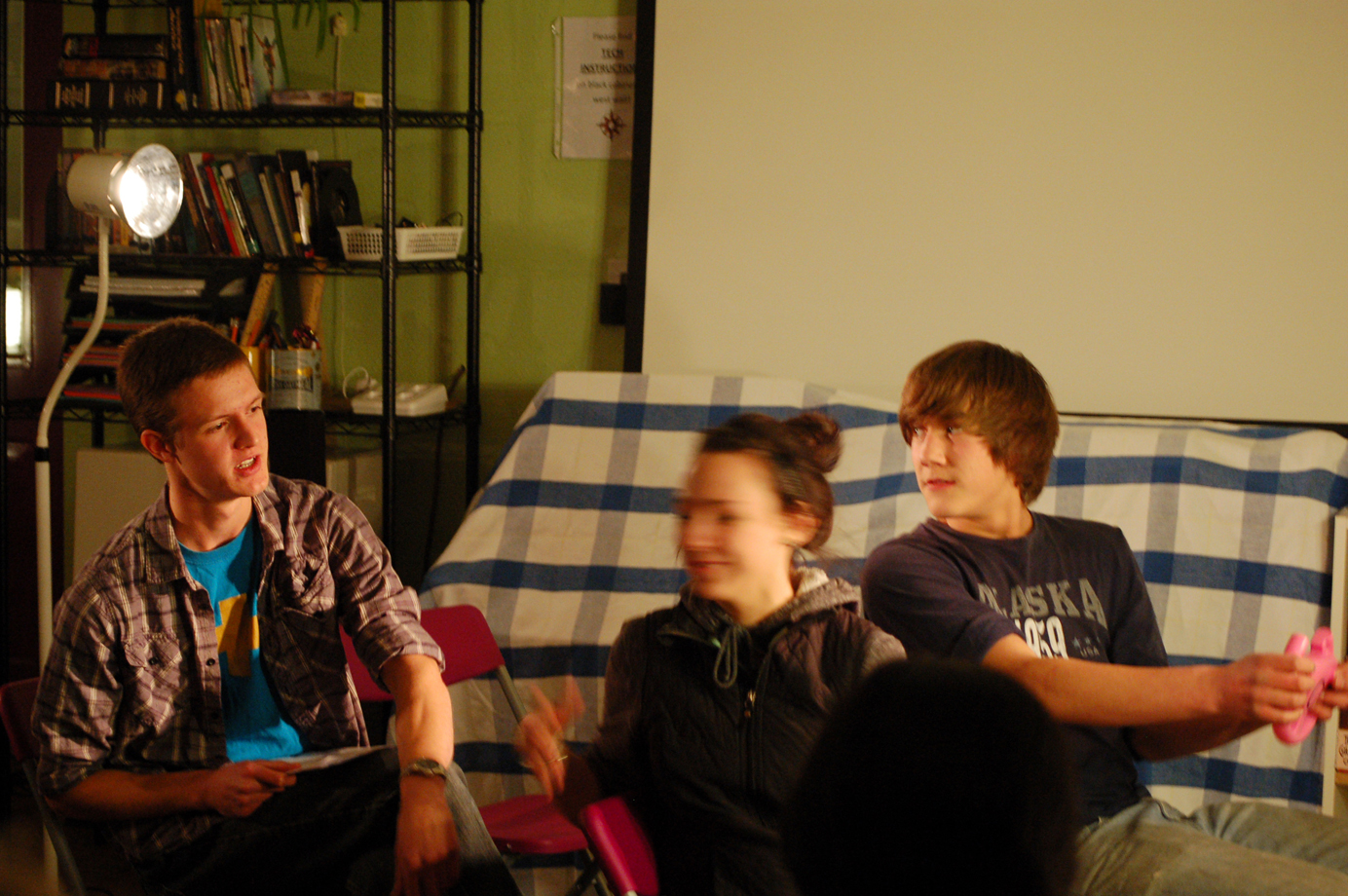Think you know the teen brain? Sure. Most of us were teenagers once. All the thrilling experiences of adolescence should come rushing back just at the thought.
Yeah, right.
Last Thursday, five high school students with Promoting Health Among Teens, or P.H.A.T., spoke on “The Amazing Adolescent Brain” at the Youth Resource and Enrichment Co-op, or R.E.C. Room. Volunteer peer educators, the P.H.A.T. team present information on adolescent health through skits and other activities.
As Doug Koester, P.H.A.T. program manager, explained to the full house of parents, adults and teenagers, remembering those teen years isn’t all that easy.
“I don’t remember actually how I felt or what I remember,” he said. “That’s because the brain changes.”
In a series of skits and short presentations with slides, the P.H.A.T. team took the audience on a way-back trip to the growing, expanding and evolving teenage brain. With the help of Dr. Linda Chamberlain, a Homer epidemiologist who speaks on the effects of violence on children and brain development, the team wrote and produced the program.
“We came up with the whole scheme-o-loo,” said P.H.A.T. member Sierra Moskios.
“It’s going to help you reflect on your own adolescence,” Koester said. “You can understand again what it is really like to be a teen.”
In one skit, pretending to be in a car, Dylan Wylde took up a toy steering wheel. Pedal to the metal, he roared down an icy street, passing a friend in another car and terrifying passengers Moskios and Trevor Waldorf. All of a sudden, a moose ran in front of the car, and Wylde narrowly missed it.
Off stage, peer educator Hailey Hughes tapped a tambourine and the action stopped. That format continued through the presentation: skit, break and short talk. Waldorf showed a slide of the brain’s building blocks as parts become more advanced — at the bottom, the brainstem, and moving up to the midbrain, the limbic brain and the cortex.
Impulsive? Oh yeah. Living on the edge? Definitely. Not thinking? Got it.
“The frontal cortex is not online yet,” Waldorf said. “What’s lost in usability is gained in flexibility.”
He explained that the part of the brain where reason, logic and rational thinking come from also is the last part to develop. Consequently, adolescents like to take risks — a good thing if they’re trying new, positive experiences, but a bad thing if they get in danger.
Young brains learn fast, but they need to develop and grow. From an evolutionary viewpoint, that’s good, because if human brains developed sooner, we’d wind up dumber, Waldorf said.
Teenagers process information from the limbic brain, the emotional core. That’s why their lives sometimes seem full of drama.
“When they’re in the spur of the moment and they’re excited, all these things can lead to distraction,” Wylde said.
In the car skit, Wylde and Moskios showed another aspect of the adolescent brain: how male and female brains differ. Moskios talked to a friend on her cell phone and said they’d pick her up. Even though she’d been to her friend’s house dozens of times, she couldn’t describe how to get there. Wylde, who’d been there a few times, said he remembered the directions.
Boys generally tend to have good spatial skills. Girls, not so much, though they’re strong in language skills. Waldorf said it all comes down to gray and white matter. In girls, the gray matter, the brain cells, develop faster. In boys, the white matter, the neurons and the myelin, or fatty tissue surrounding it, grow faster. It’s like the difference between computer servers and internet connections. Girls have bigger hard drives. Boys have more bandwidth.
The hippocampus, the part of the brain that creates long-term memories, is more sensitive to estrogen, a female hormone. The amygdala and hypothalamus are more sensitive to testosterone, a male hormone, and are related to how the body responds to fear and danger. A bigger amygdala also might explain why boys need to move around more when learning and doing things.
One thing male and female adolescent brains have in common is the need for more sleep.
“Teens are not morning people. Period,” said Hughes.
That’s why adolescents don’t do so well with early morning classes. Teens need about 9.25 hours of sleep a night, and should avoid stimulating activities like caffeine and energy drinks, and playing computer games. Teens should learn how to wind down before bed, like reading.
Developing healthy relationships and learning refusal skills is another part of the adolescent brain experience. In another skit, Waldorf and Zoe Story, another P.H.A.T. member, acted out how to avoid getting pushed into intimate behavior.
Story took the role of a girlfriend trying to encourage her boyfriend, Waldorf, to leave a party, take a walk and, you know, wink-wink. Waldorf said he wasn’t sure he was ready for that yet, and after a bit of honest partner dialogue, the two agreed to hold back.
Wylde also talked about the effects of drugs and alcohol on the adolescent brain. Growing brains are more vulnerable and teens are more prone to addiction. The lack of impulse control also makes alcohol use more dangerous.
“They’re much more likely to black out than pass out,” Wylde said. “Talk to your teens,” he added. “Don’t badger them — they might get defensive.”
A brochure on the adolescent brain written by Chamberlain is available at the R.E.C. Room on Nielsen Circle off Ben Walters Lane. Similar information is available at multiplyingconnections.org/become-trauma-informed/amazing-adolescent-brain.
Michael Armstrong can be reached at michael.armstrong@homernews.com.
Teen brains explained

Tags: Local News

